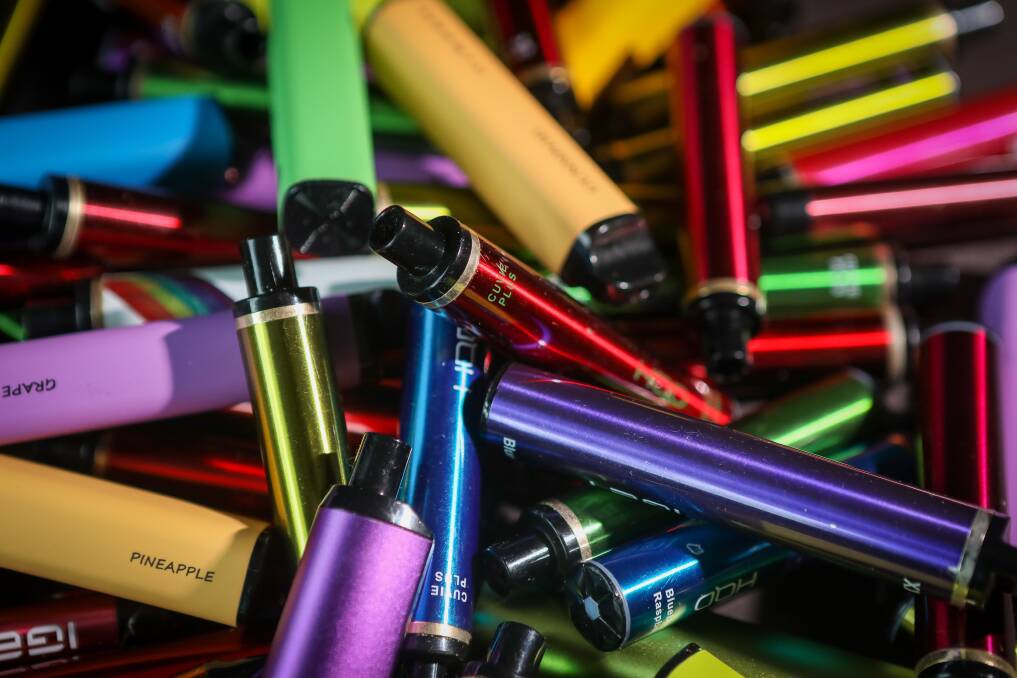Illegal nicotine vapes and e-cigarettes are a minefield of misleading packaging, deceptively high nicotine concentrations and incorrect warning labels and ingredient lists, says a former University of Wollongong scientist.
Subscribe now for unlimited access.
or signup to continue reading
Dr Jody Morgan, who now lectures at the University of Sydney, has been researching nicotine vapes and e-cigarettes in the Illawarra, and found they are both readily available and highly unregulated.
Along with a team of Wollongong researchers, she analysed 62 e-liquid samples last year, which are used in the nicotine products.
More than three-quarters of the samples had a nicotine content different to what they said on the packaging, with one sample containing almost 50 per cent more.
Most brands don't even use the word nicotine in an effort to get around regulations, and this poses a serious risk for young people, Dr Morgan said.
"If nicotine isn't mentioned, young people are potentially vaping, not knowing that they are vaping something that contains nicotine, and therefore not thinking that there's any addiction risk in what they're doing," she said.

Companies may even be changing their packaging specifically for the Australian market, removing warning labels and mentions of nicotine to get around our laws, according to Dr Morgan's research, and people are catching on.
"Regulatory bodies in Australia are getting more aware now of the fact that a lot of these samples being sold domestically do contain nicotine."
In terms of enforcing the regulation, it's a difficult dilemma, she said. For people already addicted to nicotine, vaping can be a safer option than smoking. By cracking down on nicotine vapes, it may push people back to smoking.
The solution, Dr Morgan said, is educating young people about the risks associated with vaping before they become addicted, rather than using scare campaigns.
"They are dangerous, purely from the perspective of risk of addiction and unknown consequences from flavouring molecules. And obviously, risk of exposure to nicotine to young developing brains," she said.
After the federal government's ad campaign comparing vapes and e-cigarettes to weed killer, insect poison and nail polish remover, you might be wondering what's really in that plume of vapour.
Despite the scary ad campaign, Dr Morgan said it's the risk of the unknown that is most concerning, and the risk of addiction.
"We have a lot of flavouring molecules in there and the truth is, we just don't know what the toxicity of some of these flavouring molecules is when they're inhaled," Dr Morgan said.
"You can eat them, and we have been eating them for a long time but putting them into a vaporised form and inhaling them, we just don't know what the long-term consequences of that might happen to be."
Dr Morgan said the vapes and e-cigarettes often come with a deceptively high risk of nicotine addiction, hidden by cooling agents.
"This particular compound makes the back of the throat feel cool when you're inhaling the vapour and we think that's probably to counteract the fact that some of these samples have very, very high concentrations of nicotine in them."
While vaping comes with far fewer health risks than smoking, Dr Morgan said, vapes and e-cigarettes do have cancer-causing molecules in the vapour.
The Illawarra Mercury newsroom is funded by our readers. You can subscribe to support our journalism here.


